Wita Puspita’s Indonesian Risoles: They’re a thing—and they’re delicious!
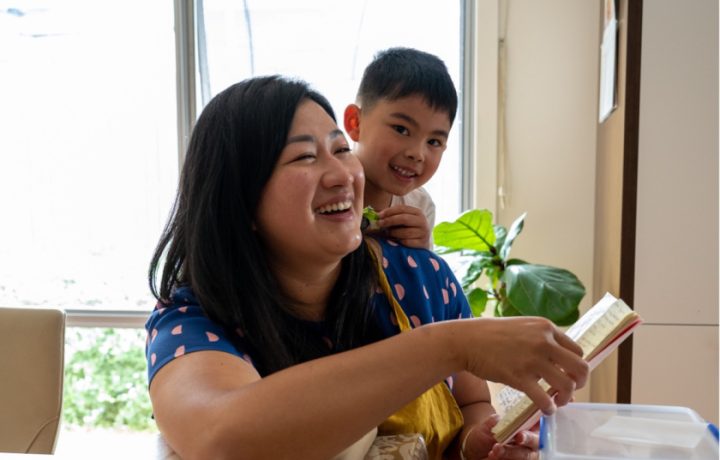
Posted on
Today we’re talking Risoles with my good friend Wita, by way of her Oma Lan.
Astute spellers everywhere are ready to point out that there is an ‘s’ missing. Not so fast.
Forget the meat and three veg, these are crumbed and fried crepe parcels, filled with a sweetly savoury chicken mix called Ragout. These Risoles are Indonesian!
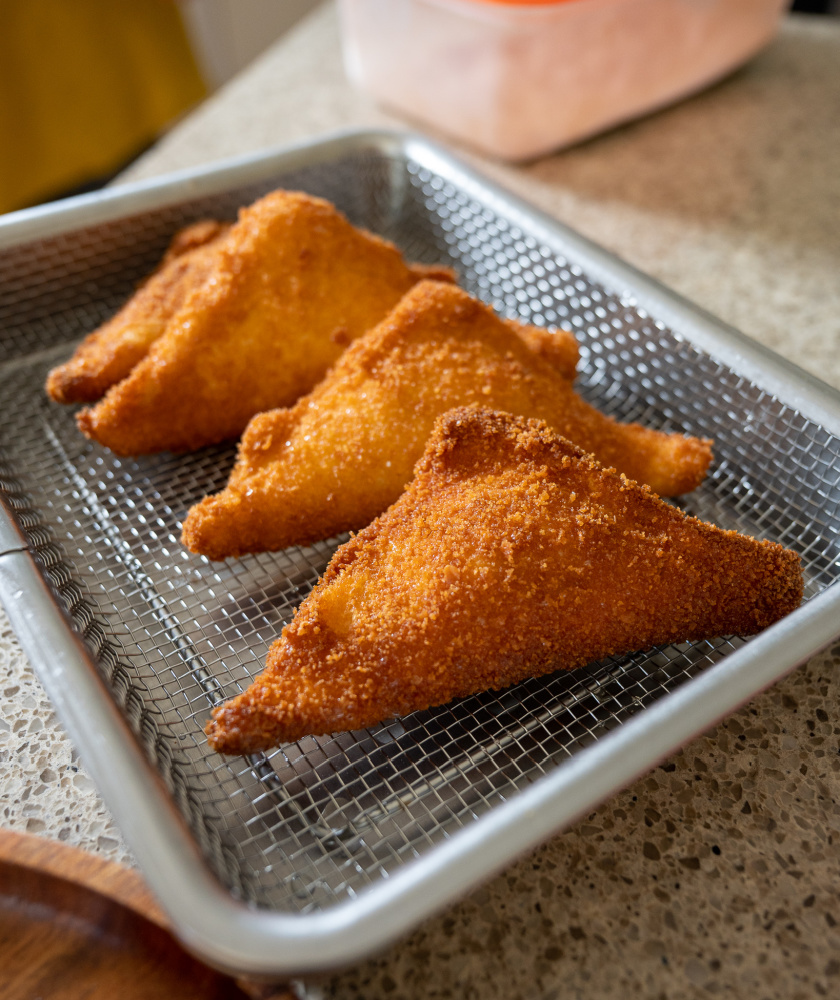
I first met Wita Puspita when I was a newbie foodie on the Canberra scene. I’d been invited to my first-ever event with a guest list and didn’t know a soul. I was filled with that existential dread that we now know as imposter syndrome! She was an old hand, having run a successful graphic design blog for ages and was used to these PR events. I clung to her like a teenager to their iPhone.
As she ushered me out of the presentation five minutes early, ensuring we hit the Hyatt seafood buffet before anyone else—both to get the best photos AND the best crab legs—I marvelled at her skills and knew we’d be BFFs for sure.
Wita has been an entrepreneur for well over a decade, having turned her graphic design career into a flourishing side-hustle specialising in stickers for diaries and planners. She’s now also the hands behind the business, Wita Makes, specialising in homemade baked goods, delicious Indonesian delicacies and the best Mochi Donuts you’ll ever eat. (In this author’s opinion!)

Wita’s Mochi Donuts. They’re neither Indonesian nor contain ragout but they’re too beautiful and delicious not to share!
Wita and her family are from Central Java, specifically the capital city, Semarang, but by the time she was ten, Wita had moved to Singapore where she attended school. Living in the spare bedroom of her mother’s work colleague’s apartment, Wita was basically given free reign and roamed the city as she pleased, feasting and getting up to a bit of mischief on the side. I have clarified this story so many times and I continue to be stunned.
“Yes, I was ten. Yes, I was basically my own boss. No, it wasn’t a boarding school or anything like that. Things were just done differently back then,” Wita clarifies, laughing at my incredulity. “It’s not a big deal”. Considering most ten-year-olds I know can barely be trusted to feed the cat and routinely show up with their t-shirt on backwards, there’s an independence in Wita that impresses me no end.
She eventually moved to Australia to study and met her husband, Starry. They shared a love for death metal music, emo outfits and food. While the Doc Martens may have been retired a while back, throughout every story Wita tells, the common theme remains—food. That part hasn’t changed.
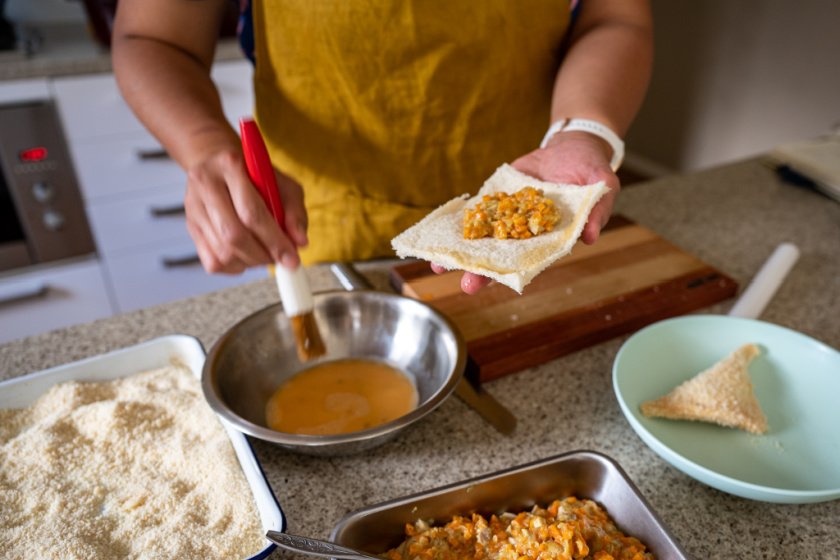
Wita follows in the footsteps of her beloved grandmother, Wulandari. Her Chinese name was Ong Kiem Lan but, as with many Chinese at the time, she had to go by her new Indonesian name ‘Lan’ or, affectionately to her grandchildren, ‘Oma Lan’.
She was an amazing cook who spoiled her granddaughter with delicious treats. In a time when independence wasn’t necessarily the norm for women, she ran a successful business in Semarang making and selling traditional snack food. It was clearly Oma Lan’s influence that led to Wita’s love of food…and business!
Oma is remembered so fondly by Wita as that warm and loving grandmother many of us were lucky to have known in our younger years. Keeping in mind that her grandfather worked in a chocolate factory, so being the most loved grandparent by a small child is a pretty big achievement. As Wita points out, she never had much of a sweet tooth but fried snacks were the way to her heart and Oma knew the way!

Wita shows me a photo of Oma Lan’s kitchen with her mother and aunt dutifully helping out the family business.
Wita remembers her mother and her aunt sitting on the floor of Oma Lan’s kitchen. They were the type of employee known the world over in family businesses—the unpaid kind! But they would pass the hours together, Oma and her two daughters, laughing and chatting in their unique dialect. Maybe a little gossiping too.
Spending time with family over food is ubiquitous across cultures. As we cook and chat in preparation for this story, Wita’s adorable five-year-old son, Jethro, pops in and out for snacks and entertains us with a steady stream of “Can I show you something?”. It’s hard to tell if he’s more excited about the food being prepared or having his picture taken, but he’s part of the narrative, just like Wita would have been at his age. Maybe one day he’ll have his own food business too?

Wita’s five-year-old son, Jethro, joins his mum in the kitchen.
I share two particular things in common with Wita. The first is that our husbands look uncannily similar. Like eerily so. A significant feat for an Indonesian Chinese man and another whose family are so Aussie they date back to the first colony. But it’s uncanny.
The second thing we have in common is that our mothers never write down a recipe. We laugh over the shared response to any cooking question—transcending our two very different backgrounds and languages—all they ever reply is “Just add enough”.
Got it. Thanks, mum.
Neither Oma Lan nor Wita’s mum ever wrote their recipes down, but she is determined to capture them. This is a cause I can get behind, being also in the process of penning my own mother’s recipes. It’s something I encourage you all to do.
This is a public service announcement: don’t leave it too late. It doesn’t have to be neat or perfect, just write something down. Or video it. Or capture it in interpretive dance… for posting on TikTok. Just don’t let those memories die!
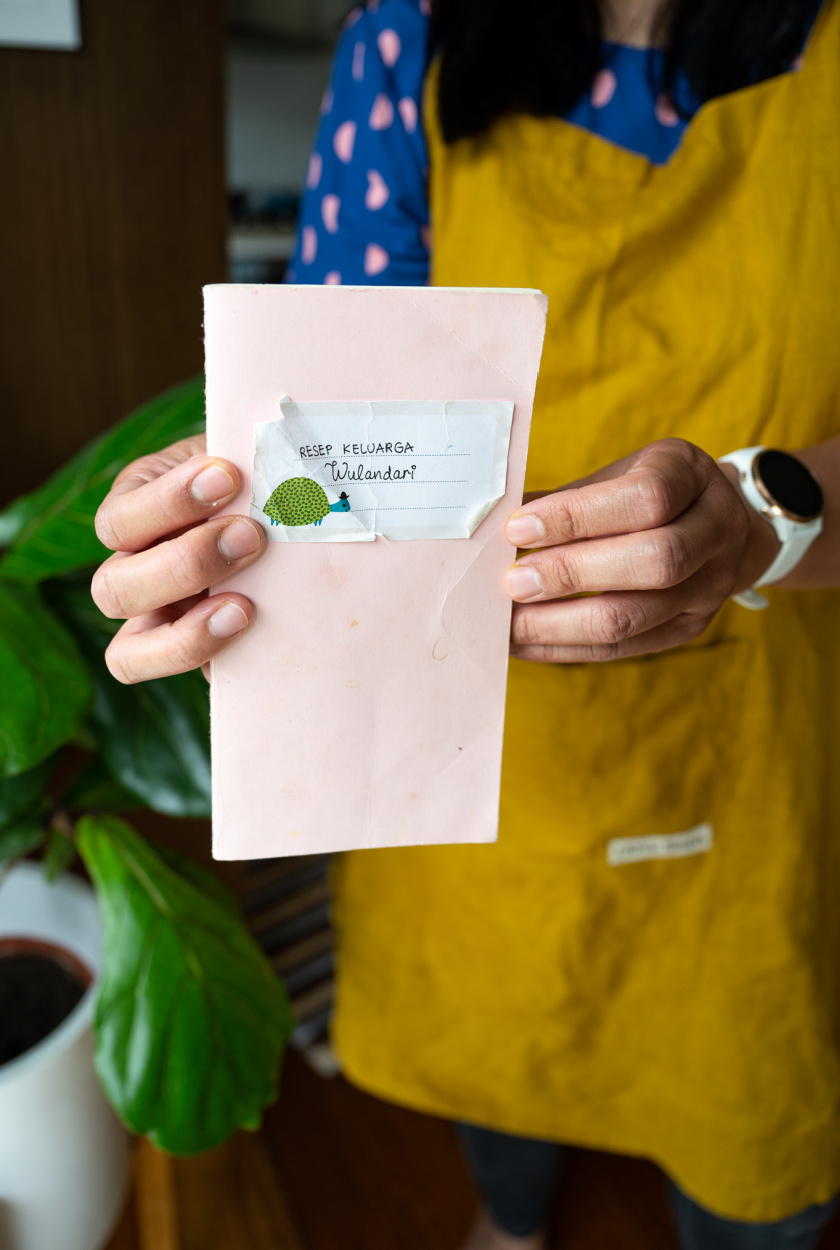
Wita has meticulously transcribed the concepts into repeatable instructions across the pages of her notebook, making little annotations as she goes (and cute drawings. Wita is a masterful illustrator!).
The thing many people fail to realise with recipes is how much personality can be conveyed in them. Wita giggles knowingly as she comes across a phrase in their dialect that she has included as a reminder.
“It doesn’t really mean as much when I say it in English but my grandma would use a funny turn of phrase that basically means ‘beat up the meat’ and I always know to give it a good bash.” I can picture Oma Lan standing over her two daughters preparing the bounty for sale and proclaiming this as an order in a loud voice while laughing.
Wita also notes that some of the words are so familiar to her yet sound entirely foreign to her husband, Starry, who comes from another region of the same country. “We say ‘gongso’ to mean stir-fry and he still looks confused when he hears it.”
I’m trying to think of an analogy in Aussie English and the best I can come up with is how confusingly endearing it is to me that Adelaidians call it Fritz instead of Devon. (Also, what’s with that?).

Wita now uses white bread instead of the traditional, handmade crepes, to wrap the ragout filling. She thinks Oma Lan would approve.
So how did a successful graphic designer start a registered home food business? Well, you can already see that it was in her blood. Back when she went to study design at university, her mum was dismissive, wishing she had gone into the hospitality game instead. As she put it “One day people may not need your drawings, but they will always need food!”
In 2020, as the bushfires forced many Canberrans to retreat into their homes under a thick veil of smoke, Wita found herself listless and began baking. Her mum’s encouragement kept coming. I get the impression that, like in many other cultures, the Indonesian mother is a powerful force when she has advice for her child. The Wita Makes business was born soon after.

Oma Lan’s Wok that was passed down to Wita’s mother and now her.
Alongside the delicious Risoles, Wita began studiously making bread and learning all about how to perfect her recipes and techniques. Did I mention that amongst her array of skills and life experience, she is actually a trained pastry chef? I can vouch that she makes not only the most pillowy soft bread but also Canberra’s most sensational Mochi Donuts.
But the biggest accolade came when someone from her own Semarang province was passing through Canberra and ordered a box of traditional Indonesian Risoles. You can see the pride escaping from her face as Wita recounts his review of the crunchy, fried morsels: “Just like back home.”
Is there a better compliment?
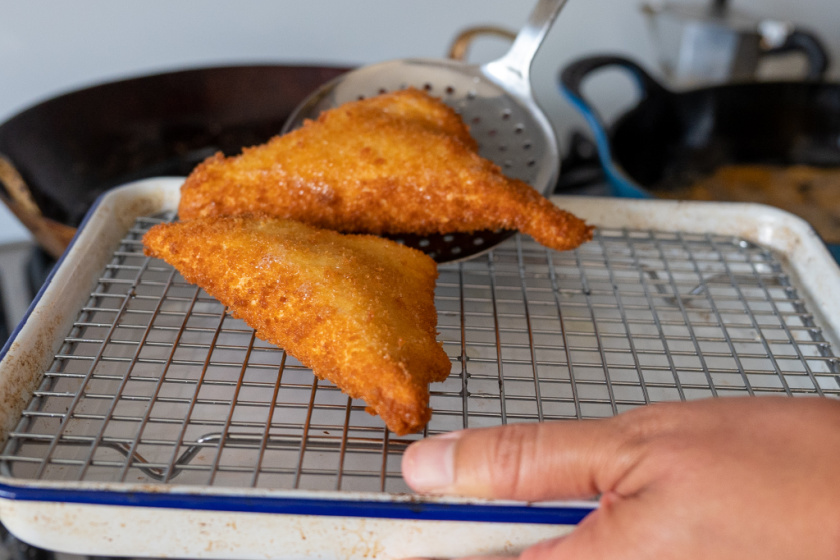
Back in Semarang, Risoles are made with a thin and silky crepe-like wrapping that takes careful work to perfect, then filled with ragout but not as we know it. It’s not a red sauce at all but a mixture of vegetables, chicken and condensed milk giving it a surprising sweetness that isn’t overpowering. Each one is crumbed and fried, creating a salty, crunchy parcel.
The ragout is a key feature in Indonesian cuisine and apart from Risoles it’s the filling fir kroket (croquette), kue sus (choux pastry), pastel (deep-fried empanada-style pastry), and many more delicious things I want to try immediately. As Wita says, anyone with enough time on their hands can perfect the laborious crepe which makes up the outer layer but it takes skill to balance the flavours just right in a proper ragout.
“It takes someone like me” she laughs.

Crispy fried Risoles with traditional Ragout filling.
Given how time-consuming the outer crepe is to make, Wita has come up with a way of using sliced white bread instead to save herself from having to make them from scratch. It makes the whole thing way easier and means she can make more of them, more often. I’m on board with this part.
Sampling the batch of freshly-cooked Risoles, made in Oma’s very own cast iron wok that was handed down to Wita a few years ago, I ask her what Oma Lan would think of her creative sliced bread modernisation. Wita laughs. “Oma was a businesswoman. If she could do the same thing but make it much quicker and easier, she’d love it!” Biting into the warm Risoles, I think I agree. I’ve tried both versions and, purists be damned, these are delicious!
Wita and Oma Lan’s Ragout Recipe
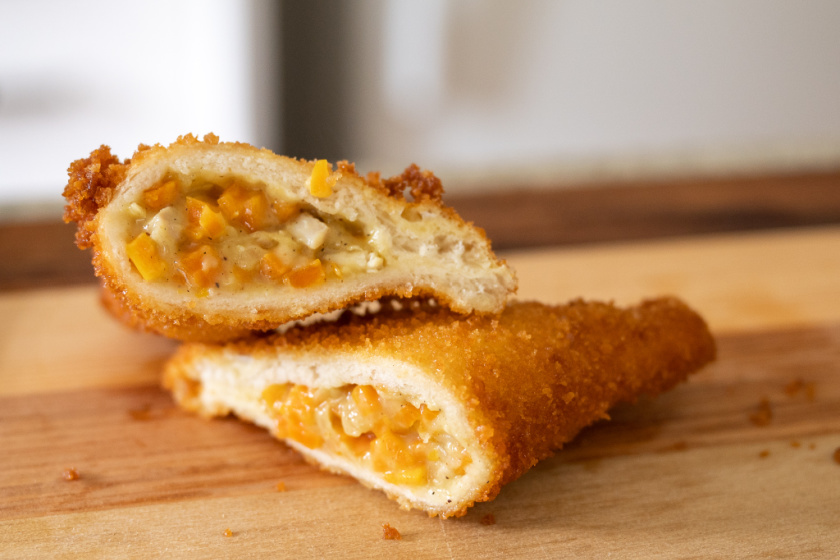
Ingredients
- 250gm chicken thigh or breast
- 300gm carrots, peeled and chopped into small dice
- 4 bulbs shallots, diced or chopped in a food processor
- water
- 1 tin condensed milk
- Ground nutmeg
- Sugar
- Powdered stock (optional)
- a few pinches of chopped parsley
- 2-3 tbsp plain flour
- Salt & pepper to taste
Method
Put the chicken in a small saucepan, cover with water and bring to boil. Turn down the heat and simmer for approximately 15 minutes. Take the chicken out, reserving the chicken broth (you will need this for later). Chop the boiled chicken into small dice.
Boil another saucepan of water and add 2 pinches of salt. Once boiling, put all the diced carrots in for 2 minutes to soften them then drain.
Get a wok or deep frying pan. Add 2 tbsp of oil, heat on medium heat.
When it’s hot, add the shallots, two pinches of salt and around 1 tsp of nutmeg (less if you don’t want the nutmeg to be too strong). Stir fry until fragrant but don’t let the shallot burn.
Add in all the carrots and 1 tsp of powdered stock (if using) along with lots of white pepper. Stir.
Add in the chicken broth, just enough to slightly cover the carrot mix. If you add too much, it’s okay. your ragout will be more on the creamy side.
Add condensed milk until the colour of the broth is a pale beige. You can add as little or as much condensed milk as you like, depending on how sweet you like your ragout.
Taste your ragout, and adjust the flavour with nutmeg, white pepper, salt or sugar if needed. When the taste is right, slowly sprinkle flour on the mixture. Cook the mixture again for about 2-3 minutes until the liquid thickens. You can add more flour if you’d like your ragout to be more solid (sometimes you’ll need a more solid ragout for recipes like Indonesian Kroket). You can also reduce the amount of flour if you’d like your ragout to be more creamy.
The Ragout is ready! Once the mixture has cooled fold in the chopped parsley.

